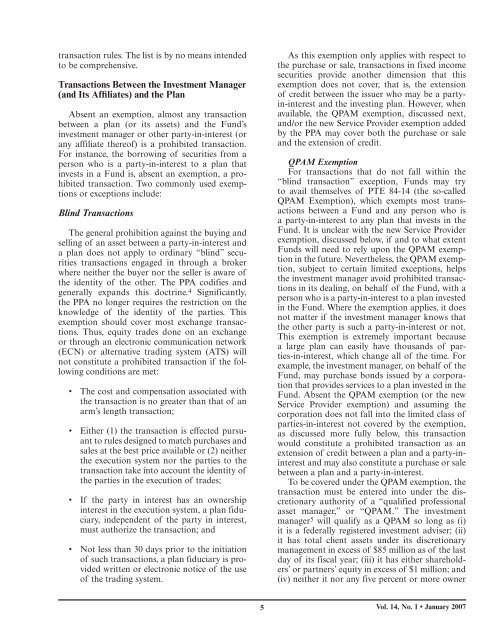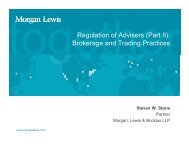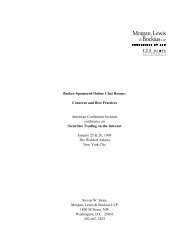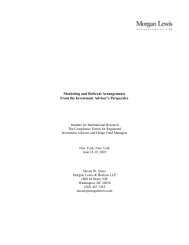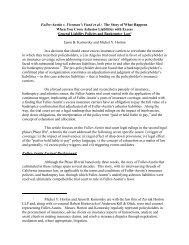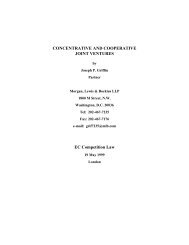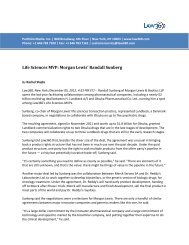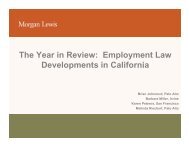What to Do if Your Fund Becomes Subject to ERISA - Morgan, Lewis ...
What to Do if Your Fund Becomes Subject to ERISA - Morgan, Lewis ...
What to Do if Your Fund Becomes Subject to ERISA - Morgan, Lewis ...
Create successful ePaper yourself
Turn your PDF publications into a flip-book with our unique Google optimized e-Paper software.
transaction rules. The list is by no means intended<br />
<strong>to</strong> be comprehensive.<br />
Transactions Between the Investment Manager<br />
(and Its Affiliates) and the Plan<br />
Absent an exemption, almost any transaction<br />
between a plan (or its assets) and the <strong>Fund</strong>’s<br />
investment manager or other party-in-interest (or<br />
any affiliate thereof) is a prohibited transaction.<br />
For instance, the borrowing of securities from a<br />
person who is a party-in-interest <strong>to</strong> a plan that<br />
invests in a <strong>Fund</strong> is, absent an exemption, a prohibited<br />
transaction. Two commonly used exemptions<br />
or exceptions include:<br />
Blind Transactions<br />
The general prohibition against the buying and<br />
selling of an asset between a party-in-interest and<br />
a plan does not apply <strong>to</strong> ordinary “blind” securities<br />
transactions engaged in through a broker<br />
where neither the buyer nor the seller is aware of<br />
the identity of the other. The PPA cod<strong>if</strong>ies and<br />
generally expands this doctrine. 4 Sign<strong>if</strong>icantly,<br />
the PPA no longer requires the restriction on the<br />
knowledge of the identity of the parties. This<br />
exemption should cover most exchange transactions.<br />
Thus, equity trades done on an exchange<br />
or through an electronic communication network<br />
(ECN) or alternative trading system (ATS) will<br />
not constitute a prohibited transaction <strong>if</strong> the following<br />
conditions are met:<br />
• The cost and compensation associated with<br />
the transaction is no greater than that of an<br />
arm’s length transaction;<br />
• Either (1) the transaction is effected pursuant<br />
<strong>to</strong> rules designed <strong>to</strong> match purchases and<br />
sales at the best price available or (2) neither<br />
the execution system nor the parties <strong>to</strong> the<br />
transaction take in<strong>to</strong> account the identity of<br />
the parties in the execution of trades;<br />
• If the party in interest has an ownership<br />
interest in the execution system, a plan fiduciary,<br />
independent of the party in interest,<br />
must authorize the transaction; and<br />
• Not less than 30 days prior <strong>to</strong> the initiation<br />
of such transactions, a plan fiduciary is provided<br />
written or electronic notice of the use<br />
of the trading system.<br />
As this exemption only applies with respect <strong>to</strong><br />
the purchase or sale, transactions in fixed income<br />
securities provide another dimension that this<br />
exemption does not cover, that is, the extension<br />
of credit between the issuer who may be a partyin-interest<br />
and the investing plan. However, when<br />
available, the QPAM exemption, discussed next,<br />
and/or the new Service Provider exemption added<br />
by the PPA may cover both the purchase or sale<br />
and the extension of credit.<br />
QPAM Exemption<br />
For transactions that do not fall within the<br />
“blind transaction” exception, <strong>Fund</strong>s may try<br />
<strong>to</strong> avail themselves of PTE 84-14 (the so-called<br />
QPAM Exemption), which exempts most transactions<br />
between a <strong>Fund</strong> and any person who is<br />
a party-in-interest <strong>to</strong> any plan that invests in the<br />
<strong>Fund</strong>. It is unclear with the new Service Provider<br />
exemption, discussed below, <strong>if</strong> and <strong>to</strong> what extent<br />
<strong>Fund</strong>s will need <strong>to</strong> rely upon the QPAM exemption<br />
in the future. Nevertheless, the QPAM exemption,<br />
subject <strong>to</strong> certain limited exceptions, helps<br />
the investment manager avoid prohibited transactions<br />
in its dealing, on behalf of the <strong>Fund</strong>, with a<br />
person who is a party-in-interest <strong>to</strong> a plan invested<br />
in the <strong>Fund</strong>. Where the exemption applies, it does<br />
not matter <strong>if</strong> the investment manager knows that<br />
the other party is such a party-in-interest or not.<br />
This exemption is extremely important because<br />
a large plan can easily have thousands of parties-in-interest,<br />
which change all of the time. For<br />
example, the investment manager, on behalf of the<br />
<strong>Fund</strong>, may purchase bonds issued by a corporation<br />
that provides services <strong>to</strong> a plan invested in the<br />
<strong>Fund</strong>. Absent the QPAM exemption (or the new<br />
Service Provider exemption) and assuming the<br />
corporation does not fall in<strong>to</strong> the limited class of<br />
parties-in-interest not covered by the exemption,<br />
as discussed more fully below, this transaction<br />
would constitute a prohibited transaction as an<br />
extension of credit between a plan and a party-ininterest<br />
and may also constitute a purchase or sale<br />
between a plan and a party-in-interest.<br />
To be covered under the QPAM exemption, the<br />
transaction must be entered in<strong>to</strong> under the discretionary<br />
authority of a “qual<strong>if</strong>ied professional<br />
asset manager,” or “QPAM.” The investment<br />
manager 5 will qual<strong>if</strong>y as a QPAM so long as (i)<br />
it is a federally registered investment adviser; (ii)<br />
it has <strong>to</strong>tal client assets under its discretionary<br />
management in excess of $85 million as of the last<br />
day of its fiscal year; (iii) it has either shareholders’<br />
or partners’ equity in excess of $1 million; and<br />
(iv) neither it nor any five percent or more owner<br />
Vol. 14, No. 1 • January 2007


